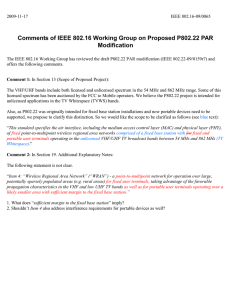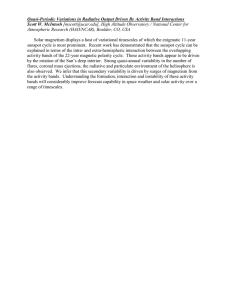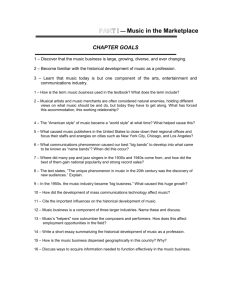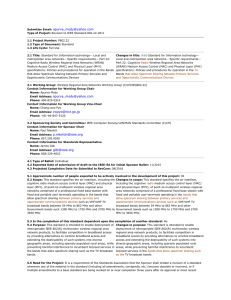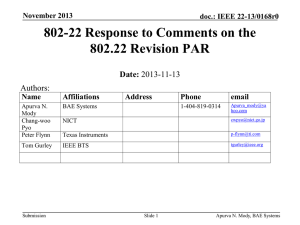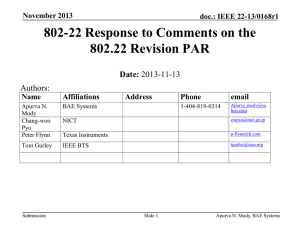Comments of IEEE 802.16 Working Group on Proposed P802.22a PAR
advertisement
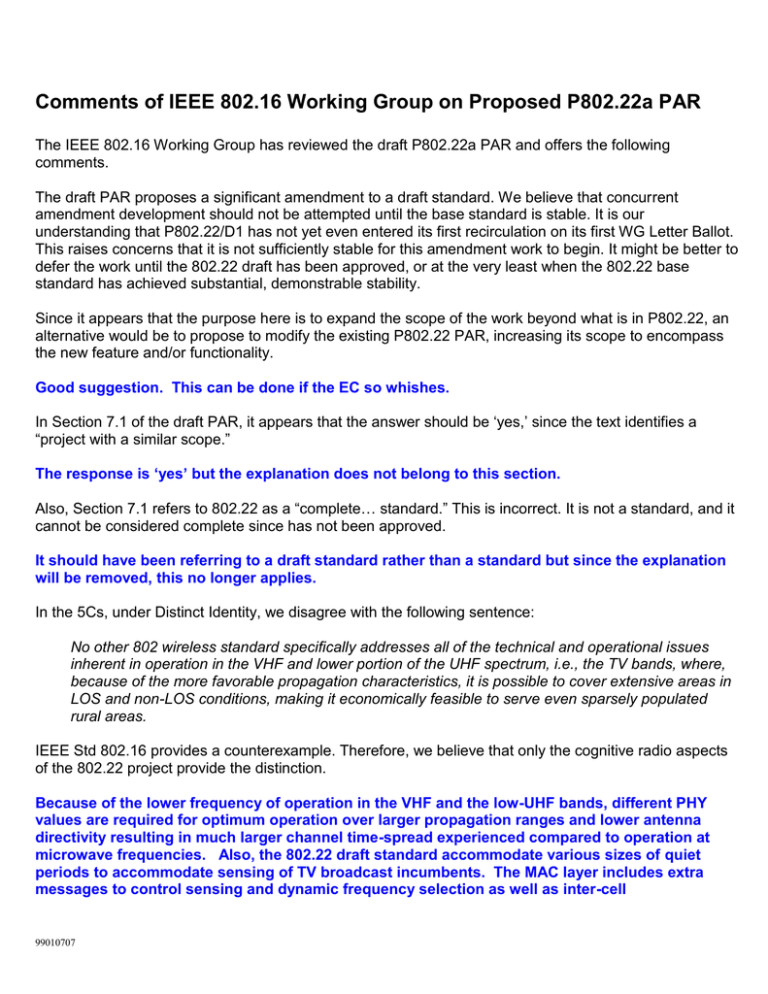
Comments of IEEE 802.16 Working Group on Proposed P802.22a PAR The IEEE 802.16 Working Group has reviewed the draft P802.22a PAR and offers the following comments. The draft PAR proposes a significant amendment to a draft standard. We believe that concurrent amendment development should not be attempted until the base standard is stable. It is our understanding that P802.22/D1 has not yet even entered its first recirculation on its first WG Letter Ballot. This raises concerns that it is not sufficiently stable for this amendment work to begin. It might be better to defer the work until the 802.22 draft has been approved, or at the very least when the 802.22 base standard has achieved substantial, demonstrable stability. Since it appears that the purpose here is to expand the scope of the work beyond what is in P802.22, an alternative would be to propose to modify the existing P802.22 PAR, increasing its scope to encompass the new feature and/or functionality. Good suggestion. This can be done if the EC so whishes. In Section 7.1 of the draft PAR, it appears that the answer should be ‘yes,’ since the text identifies a “project with a similar scope.” The response is ‘yes’ but the explanation does not belong to this section. Also, Section 7.1 refers to 802.22 as a “complete… standard.” This is incorrect. It is not a standard, and it cannot be considered complete since has not been approved. It should have been referring to a draft standard rather than a standard but since the explanation will be removed, this no longer applies. In the 5Cs, under Distinct Identity, we disagree with the following sentence: No other 802 wireless standard specifically addresses all of the technical and operational issues inherent in operation in the VHF and lower portion of the UHF spectrum, i.e., the TV bands, where, because of the more favorable propagation characteristics, it is possible to cover extensive areas in LOS and non-LOS conditions, making it economically feasible to serve even sparsely populated rural areas. IEEE Std 802.16 provides a counterexample. Therefore, we believe that only the cognitive radio aspects of the 802.22 project provide the distinction. Because of the lower frequency of operation in the VHF and the low-UHF bands, different PHY values are required for optimum operation over larger propagation ranges and lower antenna directivity resulting in much larger channel time-spread experienced compared to operation at microwave frequencies. Also, the 802.22 draft standard accommodate various sizes of quiet periods to accommodate sensing of TV broadcast incumbents. The MAC layer includes extra messages to control sensing and dynamic frequency selection as well as inter-cell 99010707 communication for synchronizing these quiet periods and facilitate coexistence. These features will be extended to the mobile/portable application. We perceive an ambiguity regarding which bands are being addressed. The Scope statement says that “Operation is limited to operation in the TV bands between 54 MHz and 862 MHz.” However, in the 5Cs, under Broad Market Potential, the response indicates that the application is to bands that are not allocated for TV: The TV bands are being studied for re-allocation on a global basis both in the ITU-R and in individual countries as they transition from analog to digital broadcasting and spectrum is freed up accordingly. Pursuing global harmonization will further broaden the applicability and increase the economies of scale of wireless networking in this region of the spectrum to the benefit of manufacturers, service providers, and users alike. If the application is to bands other than TV bands, then cognitive radio loses applicability. Many elements of the proposal (including distinct identity, and standards of similar scope) are based on the cognitive radio presumption. The transition to DTV will free spectrum in the TV bands but not necessarily a specific group of channels over a large territory. Protection of incumbent on a geographical basis will still needed and cognitive functions will still be needed. In those cases where a portion of a frequency band is dedicated to a totally different set of applications, we agree that the cognitive radio functions would not be needed as in the case of channels 51 to 69 in the US for example and this new standard would not have a clear advantage in this instance. Therefore, we suggest that the paragraph above be deleted. The paragraph could be modified to reflect the above explanation. Given the intent of the TV Whitespace EC Study Group, it might be appropriate to defer consideration of this draft PAR pending an understanding of the implications of this 802-wide activity. By the time this new activity can start, considering the usual approval process, the ECSG will likely have concluded its activities and could orient the work of the 802.22 WG accordingly. G. Chouinard 802.22 Vice-chair 2
